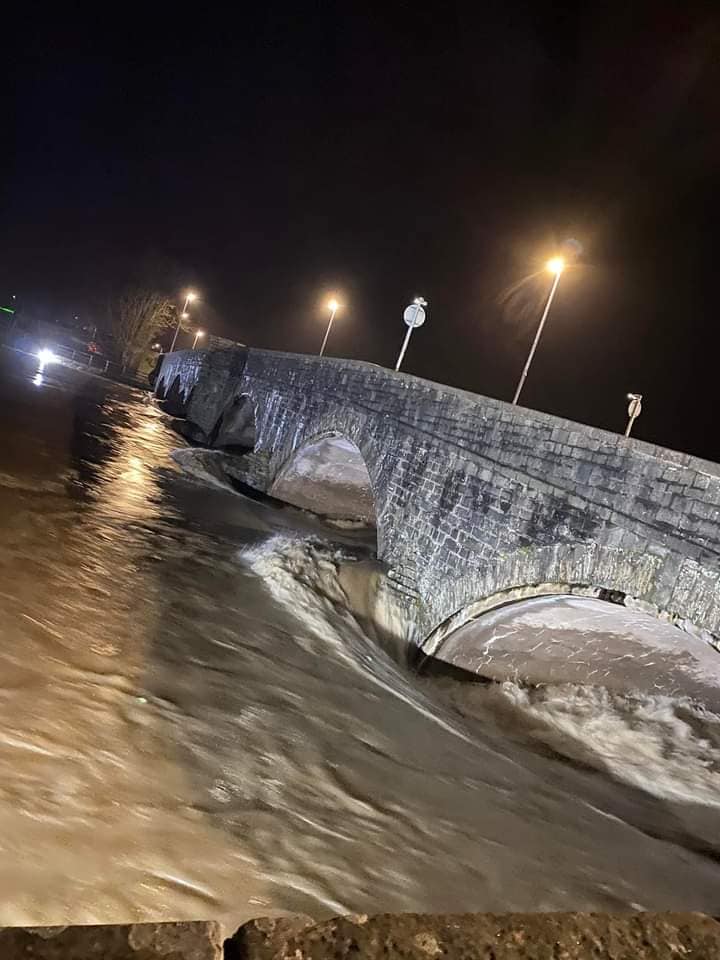It was an intense few days for Powys, along with the rest of the UK, as the county was battered by three consecutive storms - Storm Dudley, Storm Eunice and Storm Franklin.
Emergency services and local heroes worked tirelessly to help clear flood water as well as dangerous debris caused by the strong gusts brought with Storm Eunice.
While Powys did not fall within the Met Office’s red weather warning area, various areas still saw the consequences of the weather, with flooding in Brecon, Builth Wells, Crickhowell and Talgarth to name just a few areas.
Powys County Council highway staff have been praised for their actions helping to clear up damage in the wake of Storms Eunice and Franklin.
Cabinet member for Environment, Councillor Heulwen Hulme praised staff for their hard work in protecting properties, businesses and road users after high winds and torrential train lashed the county.
Councillor Heulwen Hulme said: “Once again Powys staff were at the forefront of work to deal with the impact of not one but two devastating storms to hit the county. First, we had Storm Eunice lashing the country with extremely high winds and heavy rain leaving a trail of damage and floodwater.
“Before the waters had a chance to recede, we were hit by Storm Franklin with torrential rain and more high wind, taking flood levels to the records set by Storm Dennis. Crews across Powys were in action dealing with fallen trees, flooded roads and damage to property.
“Once again, the response from our staff was magnificent, a huge thanks to them all. They were a credit to the council,” she added.
Many parts of the county were hit by the winter storms, especially on Sunday evening which saw flooding along the Promenade in Brecon, as well as the road from The Struet to Bishop’s Meadow.
While Crickhowell did experience flooding from the adverse weather, it is thought that it was not as severe as in previous storms.
It is understood that Llangynidr was almost completely cut off during Storm Franklin as the bridge over the river Usk flooded as well as the road between Talybont-on-Usk and the village.
The road between Crickhowell and Llangynidr was also blocked due to a fallen tree leaving those needing to travel with the only option of braving the B4560 mountain road to travel from the village.
Builth Wells experienced flooding near the entrance to the Groe carpark, along the A483, near its famous bull statue which is understood to have made the road difficult to pass for motorists.
The A470 near the town was also struck with deep water, meanwhile the Wye came close to record levels - according to Powys County Council’s Highways, Transport and Recycling Service - causing the river to burst its banks in Llanelwedd as well as Builth.
The whole county experienced treacherous driving conditions as well as fallen trees and missing roof tiles and guttering at the hands of the adverse weather.
Transport was halted and businesses closed their doors as residents were advised to stay safe at home.
Some residents in Powys also experienced power outages at the start of the weekend due to the storm brnging down power lines.
Talgarth residents got stuck in to clearing debris and easing the flooding over the weekend.
The Powys councillor for Talgarth, William Powell, described it as the Talgarth community “as its best” on Saturday, February 19.
He said: “Talgarth community at its best this morning, with locals coming together to help each other and deal with the flooding consequences of Storm Eunice.
“Respect to Tony Skyrm BEM, Cllr Louise Elston-Reeves, Derek Few - an off duty Dwr Cymru officer and Powys Highways heroes Julian Williams and Paul Smith, and Ysgol Y Mynydd Du Eco Committee members.”
Cllr Powell shared images of the amazing efforts to help clear the drains in Talgarth which can be seen in the garllery below.

+ 11
(View All)
The river Wye coming close to the top of the bridge in Builth Wells
There was no rest for the Mid and West Wales Fire and Rescue Service MAWWFRS as it helped communities suffering from the storms.
From pumping flood water to making streets safe from fallen debris - such as at Castle Street in Brecon when roof tiles littered the floor on Friday, February 18, during Storm Eunice.
During a 24-hour-period between yesterday at 7am - Sunday, February 20 - and tMonday, February 2, the Joint Fire Control received 100 calls of flooding within the MAWWFRS area, with the majority of the incidents in Powys.
Outside of Brecon and Radnorshire, firefighters rescued residents in Llandinam as well as people from vehicles near Welshpool.
Area Manager Peter Greenslade, Mid and West Wales Fire and Rescue Service said “This weekend has been a very busy one for our staff at Joint Fire Control and our operational crews, who have attended a high number of incidents involving dangerous structures and flooding caused by Storm Eunice and Storm Franklin.
“I would like to say a big thank you to our staff at the Joint Fire Control and to our firefighters, who have worked tirelessly and professionally, in adverse weather conditions, to protect lives and property within communities across mid and west Wales.”
While there is still some rain and wind predicted for the coming week, there are no further weather warnings in place from the Met Office.
The video, posted on Friday, February 19, showed strong wind blowing snow and terrible visibility on the Beacons biggest mountain.
A Central Beacons MRT spokesperson said with the video: “In case you are wondering what the conditions are like on Pen y Fan today [last Friday], one of our team members took this short clip whilst undertaking their personal training this morning.
“As you can see the Yellow weather warning for wind is accurate, with gusts reaching over 60mph blasting ice and snow across the tops making visibility difficult (those pinging noises were projectiles hitting our team member goggles).
“Footpaths in the area were frozen from around 300m from Pont ar Daf car park with the temperature dropping considerably the closer to the summit you get. With the added affect of wind chill temperatures are estimated to feel like -8.
“If venturing into the hills we recommend checking the weather specifically for mountains (MWIS, Met Office Mountain forecast to name a few), and consider whether you have the skills, experience and appropriate clothing and equipment to do so safely.”
Natural Resources Wales said that the heavy rain from Storm Franklin led to high river levels on the Wye and the Usk, as well as the Severn Vyrnwy and Teme.
The Welsh Government’s environment agency said that some areas saw the highest levels ever recorded – breaking some of the records set during Storm Dennis two years ago.
An NRW spokesperson said: “River levels have now peaked in most locations. We are removing some of the Flood Warnings and Flood Alerts in places as the flood risk subsides.
“Some of the warnings and alerts on the slower responding rivers, such as the Severn and Wye, will remain in place for some time. There is the potential for further Flood Warnings to be issued on the lower sections of the River Wye near Monmouth as the peak moves down stream.
“Vast low-lying land in Mid Wales have been inundated with flood water and some properties have been affected as well.”
The NRW spokesperson encouraged residents to visit its website to keep an eye on flood warnings as well as river levels.
They said: “Although these storms have caused widespread disruption across the UK, our flood defences have so far worked well to protect people and property across Wales.
“73,000 properties have a reduced risk of flooding from rivers and the sea due to the presence the flood defences NRW inspects and maintains.
“But we have to accept that we cannot stop the rain and that some flooding is inevitable. As climate change leads to more extreme weather events, we are certain to see more of the types of storms we have seen recently in the future. We must all adapt the way we live and work as the climate emergency evolves – to learn to live with variations in temperature and more water and to support our communities to become vigilant and more resilient to more frequent extreme weather events.”





Comments
This article has no comments yet. Be the first to leave a comment.